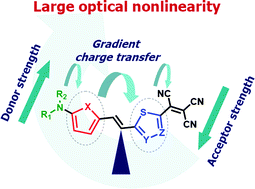Synthesis and properties of NLO chromophores with fine-tuned gradient electronic structures†
Abstract
A novel series of heterocycle-based NLO

* Corresponding authors
a
Beijing National Laboratory for Molecular Sciences, Key Laboratory of Polymer Chemistry and Physics of Ministry of Education, Department of Polymer Science and Engineering, College of Chemistry and Molecular Engineering, Peking University, Beijing 100871, China
E-mail:
nsong@pku.edu.cn
Fax: +86-10-62755644
Tel: +86-10-62755644
b
Department of Chemistry, Renmin University of China, Beijing 100872, People's Republic of China
E-mail:
jpzhang@chem.ruc.edu.cn
Tel: +86-10-62516604
A novel series of heterocycle-based NLO

 Please wait while we load your content...
Something went wrong. Try again?
Please wait while we load your content...
Something went wrong. Try again?
X. Ma, F. Ma, Z. Zhao, N. Song and J. Zhang, J. Mater. Chem., 2009, 19, 2975 DOI: 10.1039/B817789A
To request permission to reproduce material from this article, please go to the Copyright Clearance Center request page.
If you are an author contributing to an RSC publication, you do not need to request permission provided correct acknowledgement is given.
If you are the author of this article, you do not need to request permission to reproduce figures and diagrams provided correct acknowledgement is given. If you want to reproduce the whole article in a third-party publication (excluding your thesis/dissertation for which permission is not required) please go to the Copyright Clearance Center request page.
Read more about how to correctly acknowledge RSC content.
 Fetching data from CrossRef.
Fetching data from CrossRef.
This may take some time to load.
Loading related content
